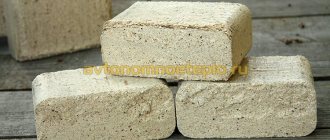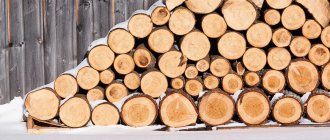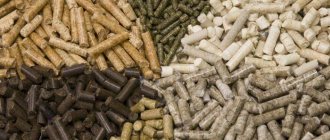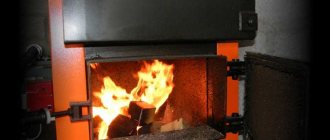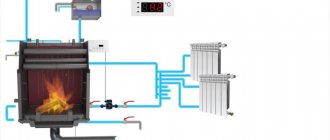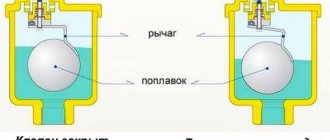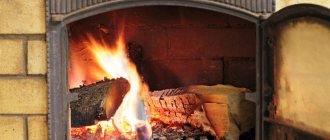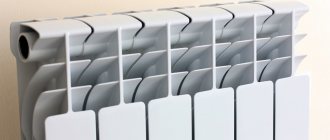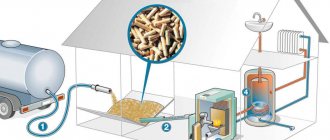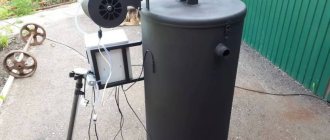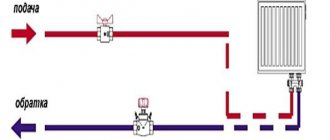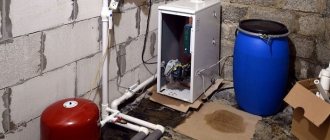Pellets and briquettes are modern types of fuel that are superior to traditional firewood in terms of heat capacity and are optimally suited for boilers with automatic feed.
They can also be burned in conventional heating stoves or boilers, but this method is only effective for briquettes, and for burning with pellets you need a special device - a pellet burner .
In this article we will talk about:
- various heating methods;
- combustion of pellets and briquettes;
- features of heating with pellets and briquettes;
- boilers with automatic fuel supply;
- features of the choice of boilers for heating with briquettes and pellets.
Methods of heating houses
All heating methods can be divided into:
- fuel combustion method;
- method of transferring thermal energy.
There are only 3 ways to burn fuel:
- Traditional , in which the fire spreads from bottom to top (the same method is implemented in boilers with automatic fuel loading).
- Pyrolysis , that is, the decomposition of wood into a minimum amount of ash and pyrolysis gases, which are then burned in a special chamber. Read more about pyrolysis and differences from other methods of burning wood in the article “Pyrolysis gas and its application.”
- Top combustion , in which the fire moves from top to bottom, read more about it in this article (Stropuwa boilers).
There are only 2 ways to transfer heat:
- Water heating , including heated floors.
- Direct radiation of heat (furnaces and rough).
How to make pellets from sawdust, straw or husks with your own hands
First of all, it is necessary to carefully calculate the feasibility of this event. If the raw materials for the pellets are free or the owner got them for next to nothing, then the implementation of the idea will be profitable.
To produce pellets, two components are needed: raw materials and equipment. Sawdust, husks or straw are also not suitable, they need to be prepared first:
- Only softwood will make it possible to produce high-quality pellets. Sawdust from hard types of wood will have to be mixed with softer ones, otherwise granules will not form - the pellets will crumble into powder, and when burned they will produce a large amount of ash.
- The humidity of sawdust plays an important role in the production of pellets - it should be at the level of 12%. Wetter sawdust will have to be pre-dried (straw and husks, as a rule, are initially well dried), and overdried raw materials must be moistened, otherwise the granule will not form.
- Sawdust of a large fraction must be crushed, since sawdust or straw, previously cut into small pieces, is fed into the granulator.
Based on these requirements, it is easy to determine the number of pieces of equipment in a production line for making pellets with your own hands:
- crusher for primary grinding of branches, wood chips and bark;
- drying or drying chamber;
- another crusher for finer and better grinding of sawdust;
- humidifier for sawdust;
- granulator;
- cooler for finished pellets.
Each of these devices needs to be described in more detail, but it is the working tool that deserves the most attention - a granulator or a press for squeezing out granules.
Pre-treatment of sawdust
Before pressing, raw materials for pellets must go through several stages of preparation:
- primary grinding, during which branches are cut, bark, twigs and other hard and large fragments that can be caught in sawdust are broken. For these purposes, it is necessary to use a crusher capable of crushing sawdust to a size of 1.25 cm³. You can avoid this stage if you use high-quality sawdust from furniture or carpentry, straw or husks.
- Sawdust must be dried in special chambers with high temperatures. The moisture content of the material after this stage should not exceed 8-12%.
- In small hammer-type crushers, dried sawdust is crushed to a fraction of 1.5 mm. The straw is cut with special scissors.
- In order for the sawdust or hay powder to clump, it must be moistened again. Sawdust from soft wood is irrigated with water, while sawdust from oak or beech must be treated with hot steam.
Attention! Making pellets from straw is much easier than making pellets from sawdust. The straw does not need to be dried; it is chopped with scissors rather than crushers, and, due to its softness, the straw is much easier to press through the holes of the granulator. Less equipment, less power spent on granulation - the result is lower costs for the production of pellets.
Pressing of raw materials
The granulator is the most important and most expensive piece of equipment for the production of fuel pellets. This device can be purchased, but craftsmen with access to a lathe and welding machine can make a pellet press with their own hands.
There are several types of pellet granulators:
- A screw press resembles a regular meat grinder - the same shaft moves inside it, and a mass of crushed sawdust is pressed through a matrix with holes. It’s not difficult to make such a press with your own hands, but its power may not be enough for sawdust granulation; a screw granulator is more suitable for straw and husks.
- Flat die presses are the most popular type of equipment in home pellet production. Sawdust is poured into a hopper, at the bottom of which there is a matrix with holes; two toothed cylinders roll along this flat matrix, which press the sawdust to the holes, pushing them through and forming granules. It is quite possible to make such a granulator yourself, you just need to know how to use a milling and lathe. There are press parts for sale, which allows you to simply assemble the device from ready-made parts. It is enough to purchase an electric motor and a metal matrix, after which you need to assemble a pellet pressing machine from all the parts.
- Presses with a cylindrical matrix are considered the most productive, therefore, they are most often used on an industrial scale. The principle of their operation is the same as the previous granulators, only the toothed rollers are located inside a large cylinder with holes, and roll along its walls, pressing a mass of crushed sawdust. There is a knife installed outside that cuts the granules to the required length.
Advice! Home sawdust granulators, as a rule, are not very powerful, so they work quite slowly. In order not to stand near the hopper all the time and not fill up the raw materials, you can make a screw conveyor along which the sawdust will move to the granulator hopper at a certain speed.
Final stage
During the pressing process, sawdust is heated to 70-90 degrees; in this form, the granules are very brittle, they can easily crumble and deteriorate. Therefore, the pellets must be cooled immediately after leaving the granulator. To do this, they are placed on flat pallets and blown with cool air or left to cool in natural conditions.
After cooling, the granules become hard and are no longer so easy to break. Now the pellets need to be sifted to separate unformed parts, dust and fine wood powder - all this causes the appearance of excess ash on the walls of the boiler.
Screened sawdust pellets can be placed in plastic bags and stored until the next heating season.
Important! In the room where sawdust pellets are stored, fire safety standards must be strictly observed, since the material is highly flammable.
How pellets and briquettes burn
Despite the fact that the combustion of pellets and briquettes is based on the process of pyrolysis, that is, the release of flammable gases when wood is heated and their subsequent combustion, these materials burn differently .
Pellets due to:
- small size;
- dense laying
They do not allow air to pass through them well, so the traditional movement of fire from the bottom up is ineffective .
For efficient combustion, it is necessary to either reduce the thickness of the pellet layer placed in the firebox, or use the movement of fire from top to bottom.
You can read more about this combustion process, as well as the equipment for it, in this article.
Reducing the thickness of the pellet layer in the firebox leads to a reduction in their burning time , and therefore the need to frequently add fuel to the stove or boiler.
There are boilers with automatic pellet feeding that completely solve this problem. Pellets are poured into a hopper, from which they automatically enter the firebox. The pellet supply is regulated by automation , which determines the temperature of the coolant (water) or exhaust gases and uses them to estimate the remaining fuel in the firebox.
The combustion of briquettes
depends on their shape .
Rectangular briquettes (RUF, brick) burn in the same way as firewood, that is, the denser they are stacked, the longer they will burn, releasing less heat.
The greater the distance between them, the faster they will burn, releasing more heat.
Regardless of the installation method, the total amount of thermal energy that will be released during the combustion of briquettes is the same .
In contrast, briquettes of the Nestro type (round) burn equally no matter how they are laid , because there is enough space for passage between them:
- air;
- pyrolysis gases.
Briquettes like Piny & Kay burn in the same way - octagonal logs with a through hole in the middle.
Therefore, for ordinary ones:
- ovens;
- fireplaces;
- boilers,
which do not have an automatic fuel reloading system , any type of pellets are effective.
How to install
You can try to install a pellet boiler at home with your own hands if you have special knowledge or by using the Internet, where step-by-step instructions are provided. However, it is better to entrust the solution to this issue to professionals from a specialized organization that has a construction license, who will reliably install the unit during repair or construction.
Design must be completed before installation can begin.
Main stages
1. Preparatory:
- preparation of the premises;
- strengthening and leveling a fireproof base capable of supporting the unit;
- electrical wiring;
- installation of ventilation and chimney.
2. Installation and piping:
- installation on a hill, connection to the chimney of the gas-air duct;
- bunker installation, auger connection;
- control panel assembly;
- circulation pump piping;
- installation of an expansion tank;
- installation of automation for return control;
- wiring of backup power supply, installation of stabilizer;
- connecting the coolant and return circuits.
3. Commissioning activities:
- control of compliance with the project;
- leak testing;
- automation check;
- crimping;
- control start-up and parameter measurement;
- adjustment work.
4. First launch:
- filling the container with pellets;
- checking water pressure, replenishing it to the standard if necessary;
- opening the smoke damper;
- ignition - by control panel or manually;
- checking the compliance of the parameters with the project;
- stopping after burnout;
- control of coolant temperature to prevent condensation formation.
Common mistakes
- Lack of return temperature control.
- Unsatisfactory tightness of the gas circuit, decreased efficiency due to leakage of pyrolysis gas;
- Poor thermal insulation of the base, causing condensation and the release of harmful substances.
- The size of the boiler room does not comply with fire safety requirements, which does not allow servicing the bunker or auger.
Pellet boilers are characterized by efficiency, ease of operation, and long battery life. But optimal parameters can only be achieved if the equipment is correctly selected, installed and configured.
Enjoy the shopping! Take care of yourself and your loved ones!
Features of application
The main problem that arises when heating with any solid fuel is that the burning time of one bookmark with maximum efficiency does not exceed 1–2.5 hours . This fully applies not only to firewood or coal, but also to pellets and briquettes.
Therefore, solid fuel heating is implemented in three different ways:
- increase burning time;
- store the released thermal energy;
- use automatic fuel loading systems.
Increased burning time
The burning time of such fuel is increased in two ways:
- burning from top to bottom;
- restriction of air supply.
Combustion from top to bottom is implemented in boilers and furnaces of the “Stropuva” type, however, such devices are very demanding in terms of :
- fuel quality;
- cravings;
- temperature of the returning coolant.
In addition, boilers of this type are not cheap , their average cost is 100 thousand rubles.
Increase in combustion time due to air supply limitation dramatically:
- reduces the efficiency of the boiler or furnace;
- increases fuel consumption.
How to store thermal energy
More efficient systems are those that store thermal energy to then heat the house for a long time.
Such systems include:
- brick kilns;
- fireplaces with rough brick;
- water boilers of excess power with a heat accumulator (TA).
Brick stoves and fireplaces with rough materials store heat due to the high heat capacity of brick . The temperature of the gases inside the furnace reaches 1000 degrees, so during the burning time of one bookmark (1–2 hours), the brick walls store enough heat to heat the house for 12–20 hours.
Coal and wood stoves work well with briquettes, but heating with pellets requires a pellet burner because pellets are not well suited for such devices due to their combustion characteristics.
Excess power boiler with heat storage
Another option for a system that stores heat is an excess power boiler with a water heater .
Excessive boiler power is necessary in order to release enough heat during one fire to heat the house for 50–70 hours.
In this case, the capacity of the heat accumulator is determined by the formula V=S/10, where:
- V – area of the house in m2;
- S – TA volume in m3.
The boiler power for a well-insulated house is determined by the formula P=S/2, where:
- P – boiler power in kW;
- S – area of the house in m2.
Such systems work well on any type of fuel , so pellets and briquettes have no advantages, except that these materials are cheaper than any other fuel.
also no advantage when using conventional or pyrolysis solid fuel boilers, in which it is necessary to add fuel after 2–6 hours .
However, any of the described systems works well on pellets or briquettes, so the cost of fuel decides everything .
Automatic fuel loading systems
Pellets and briquettes are most effective in boilers with automatic fuel supply . Despite the fact that some models of such boilers can run on wood or coal, pellets and briquettes are preferable. Pellets because of their small size, and briquettes because they have the same shape.
All systems of this type can be divided into:
- pneumatic;
- screw;
- conveyor;
- elevators;
- monoblock.
Pneumatic
Pneumatic systems combine forced air supply to the combustion zone and fuel supply, therefore they are only suitable for boilers operating on:
- pellets;
- wood chips
In such systems, exhaust gas temperature sensors are installed that determine the intensity of combustion.
Therefore, the amount of air and fuel supplied over a period of time is precisely dosed to ensure the most efficient combustion .
During warming up, the amount of air and fuel is maximum, so a strong fire burns in the firebox.
When the temperature in the house has reached the set value, the automation reduces the supply of fuel and air, due to which the boiler switches to low power mode and maintains the temperature .
In pneumatic systems, the boiler and compressor are connected by a thick pipe, the diameter of which is sufficient for the free passage of pellets in any position.
In this case, the diameter depends on the power of the boiler, because even in temperature maintenance mode, the speed of air movement in the pipe must be sufficient to transport fuel .
A dosing device installed under the hopper regulates the fuel supply by changing the cross-section of the hole through which pellets fall into the air duct. On some models, instead of a hole with a variable diameter, a screw drive is installed, providing more precise adjustment .
The main disadvantage of pneumatic systems is their large size, because the pipes take up a lot of space. Therefore, they are installed only in certain rooms. In addition, the boiler can be installed in one room, and the bunker and compressor in another.
Screw
Screw automatic fuel supply systems operate on the same principle as a screw in a meat grinder . A rotating screw moves material from the hopper to the firebox.
By turning the engine on and off, as well as changing its rotation speed in high-power boilers, the supply of fuel to the furnace is regulated.
Such devices are much more compact than pneumatic ones, because in most cases the bunker and boiler are combined into one device. The exception is high-power boilers ; bunkers for them are installed separately and connected to each other by a screw conveyor.
Depending on the firebox model, the screw conveyor delivers pellets either directly into the combustion zone or into the upper part of the firebox, from where the pellets fall into the combustion zone.
In both cases, the hole through which the fuel enters the boiler is closed by a metal valve controlled by an electric motor or solenoid. Therefore, the hole opens only during fuel loading , after which it closes hermetically.
This system protects burning fuel from excess air and also prevents smoke from entering the room.
Boilers with a screw feed are in maximum demand, because without modification or changing settings they can operate not only on pellets, but also on such types of fuel as:
- wood chips;
- sawdust;
- crushed biomass;
- peat;
- black and brown fine coal.
Conveyor
In such systems, the bunker and firebox are connected by a conveyor with:
- tape;
- mesh;
- trays.
The advantage of systems of this type is the ability to supply fairly large fragments to the boiler, which is beyond the capabilities of pneumatic and screw systems, so they are used for boilers operating on:
- coal;
- firewood;
- briquettes.
Due to the fact that firewood and coal consist of fragments of different sizes, difficulties arise with dosing , so in addition to the conveyor, it is necessary to install a complex and expensive loading device.
Briquettes do not have this drawback, therefore, to work with the conveyor, they use the simplest cassette storage facilities, in which the briquettes are stacked in neat and even cassettes.
In such systems, briquettes are first selected from the furthest cassette, then moved to the front, and all this does not require any complex automation .
However, the conveyor system is very poorly suited for pellets, because it is necessary to install a complex loading device based on an auger , and also use not a metal mesh or trays, but a rubber band, which is sensitive to high temperatures.
Therefore, such a system can only deliver pellets to the top of the boiler, where the temperature is not too high, then the pellets will fall into the combustion zone.
This loading method leads to the release of a large amount of combustion products, so the boiler cannot be used in residential buildings or in areas where people are often present.
Elevators
Loading systems of this type are most often used for wood-fired boilers. The elevator lifts the fuel, and the guide located on top sends the top layer of fuel into the boiler.
Such systems can also be used for heating with briquettes, because the guide will send them into the firebox in the same way as firewood.
The main disadvantage of systems of this type is the very high price, therefore for briquettes in which each log corresponds to one:
- form;
- size,
It makes no sense to use such complex and expensive systems.
Monoblock
This is the most popular way to use pellets in boilers of small (up to 50 kW) power.
A bunker is installed above the boiler, which contains enough fuel for heating at maximum mode for at least a day.
After the sensors detect a decrease in the temperature of the exhaust gases, an electric motor or solenoid opens the valve between the boiler and the bunker for a strictly defined time .
Thanks to this, a certain volume of pellets is poured into the firebox, necessary to release the required amount of thermal energy.
All calculations are performed by a built-in processor , which evaluates many parameters and supports combustion in the selected mode.
Automatic cleaning of the firebox and grate
However, automatic fuel reloading is not the only problem that needs to be solved to increase the boiler operating time from one fill, because sawdust and briquettes leave behind ash, which reduces the air supply from below to the combustion zone .
Therefore, automatic ash removal is necessary:
- firebox;
- grate.
To do this, the grate is connected to a vibrator based on:
- electromagnet;
- electric motor.
Based on a signal from the processor, the vibrator pulls the grate, the ash spills down, and the coals and burning fuel remain on the grate .
The same systems are used on any automatic solid fuel boilers, regardless of the type of fuel they operate on.
What are pellets?
This is waste from the woodworking and agricultural industries compressed into granules. Since the granules are produced without chemical additives, these products are hypoallergenic and environmentally friendly. Pellet heating is a relatively new phenomenon in our country. Due to the fact that prices for diesel fuel and electricity have increased significantly, the population began to look for alternative and economical sources of heating. So, pellets came to us from Europe.
New manufacturers have appeared, they have become more accessible and cheaper. And if initially the pellets were wood or coal, later they began to be made from agricultural waste - husks, straw, corn.
Pellet classification
Due to the increased demand for alternative fuel, more and more new varieties of pellets are appearing. Depending on the raw material, granules are:
- woody;
- peat;
- granules from solid household waste;
- coal
- from husks.
Depending on the degree of purification, granules come in three grades:
- higher (domestic or white);
- standard (industrial);
- economy (agropellets).
Household pellets
They belong to the highest grade fuel. This is the optimal choice for heating frame houses. Granules are made from sawdust. Soft and hard wood is used as raw material. They have extremely low ash content - less than 0.5%. This means that the boiler needs to be cleaned no more than once a month. Heat transfer is high, 17.2 MJ/kg. Household granules are white. This effect is achieved by debarking the wood, which is carried out before crushing and granulating. And this means higher fuel efficiency. Suitable for any type of boiler.
Industrial pellets
They have a slightly lighter color than agropellets. They are made primarily from unbarked wood. The heat transfer of this category is 17.2 MJ/kg, ash content – from 0.7%. The frequency of cleaning the boiler surface when using such granules depends on how high their ash content is.
Agropellets
They belong to the economical fuel class. This type of fuel is the cheapest. Sunflower seeds and buckwheat hulls are added to the granules. Since these pellets are not debarked, their color is very dark. The ash content is from 3%, and the heat transfer is 15 MJ/kg. Typically used in large industrial boilers. If automatic cleaning is not provided, the inside of the boiler must be cleaned every day.
Pellet burning
Any fuel produces heat when burned. This process occurs gradually and is divided into four stages: evaporation of water, gasification and combustion of pyrolysis gas (the main process) and combustion of charcoal. In order for these processes to take place with the greatest heat transfer, a sufficient volume of oxygen must be provided in the combustion chamber.
How often should you add pellets to your boiler or oven? There is no single recommendation for this issue; it all depends on your equipment – its consumption and the volume of pellet bins. There are different types of bunkers: some of them can be filled with fuel several times a year, and some of them once every few days. The amount of fuel consumed also depends on the size of the house.
The combustion process of fuel pellets
Pellet consumption
What is the consumption of a pellet boiler or how many pellets are needed for heating? Consumption directly depends on the design of the heating system, as well as on how insulated the room is. For every 100 m2 of living space per year, approximately 2000 m3 of gas or 4.3 tons of pellets are required.
What power should you set? There are two types of power selection: precise and primitive. An accurate assessment will require an audit of the premises.
A primitive calculation should be made based on the fact that for every 10 m2 with a height of up to 3 m, 1 kW of power will be required. Thus, for a frame house with an area of 150 m2, a 15 kW boiler is needed.
One full load of the boiler can last for 4-5 days!
How to choose quality
When choosing granules, you should be guided by the following signs:
- Smell. A sign of good quality is the slightly sweet smell of glue. The granules should not smell like spruce.
- Length. Pellet length is limited to 50 mm for suction systems. However, it should not be too short.
- Diameter. Most often, the diameter of the granule is 8 and 6 mm, much less often 10 and 4 mm. The diameter determines how the boiler or furnace operates for efficient heating. If the diameter is larger or smaller, this means that the production of fuel pellets is not the manufacturer’s core business.
- Color. They can be dark or light in color, but not gray. This is a sign that the raw materials have been in a damp place for too long and fungus has appeared.
- Surface. The smoother the surface, the stronger the granule. There should be no swelling or cracks.
- Dust. A large amount of dust is a sign of poor quality and rapid abrasion. This can also lead to raw materials being claimed. If you store the granules in a closed bag, there will be much less dust.
Quality in granules and bags
Pellet price
The cost depends on their type and volume that you are going to order. Some suppliers sell at least several tons of product, but there are also retailers who sell fuel pellets in bags. It is worth noting that this year there has been a sharp drop in prices for wood fuel of all categories. Thus, premium pellets from coniferous species today cost from $85 per ton, simpler agropellets and industrial ones cost from $50 per ton.
How to choose automatic boilers
Since automatic boilers are the most convenient , we will give recommendations that will help you choose the right boiler.
Here is a list of recommendations:
- select the fuel type;
- determine the boiler power;
- determine the cost limit;
- choose a boiler by fuel type, power and price.
Selecting a boiler based on fuel type is necessary because briquette boilers are difficult to adapt to operate on pellets and vice versa .
Therefore, determine what type of fuel you need:
- more accessible;
- costs less.
Read more about the characteristics of pellets and briquettes, as well as their production technology, in this article.
After this, determine the boiler power taking into account:
- squares;
- insulation;
- heating method.
For automatic boilers, a heat accumulator is not required , so their power is calculated using the formula P = S/10, where:
- P – boiler power in kW;
- S – area of the house in m2.
This formula is used only for well-insulated houses . If the house is without insulation, then the boiler power must be increased.
Only a heating engineer with experience working with heating systems can make more accurate calculations.
After this, determine the financial limit for the purchase of a boiler , because the cost of automatic devices, depending on the manufacturer and power, is 60–400 thousand rubles.
Price
We have compiled a table of the most popular models of automatic boilers that can operate on pellets and briquettes made from pressed sawdust:
| Model | Fuel type | Power, kWt | Description | Price (thousand rubles) | Manufacturer or seller website |
| Metal-Fach SEG BIO- 19 kW | Pellets | 19 | Polish automatic pellet boiler of low power. It can also work on fine coal (automatic mode), coarse coal, firewood and briquettes (manual loading). | 227 | heat-trend.ru |
| Vulkan EKO-24 kW | Pellets | 24 | Russian automatic pellet boiler of low power. It is possible to order with a larger hopper, which will extend the life of one load of fuel. Due to the large volume of the ash pan, it can be cleaned simultaneously with loading fuel with any bunker volume allowed for this model. | 167 | heat-trend.ru |
| Faci 51 | Pellets | 51 | Italian medium power boiler with screw drive. The bunker volume is up to 400 liters, you can choose when ordering the boiler. Equipped with an automatic ash removal system. | 269 | biensi.ru |
| Teplodar Kupper OK 20 | Pellets | 20 | Russian pellet boiler with screw feed. Hopper volume 240 liters. | 85 | teplosvarka.ru |
| Forester | Briquettes, firewood | 15 | Automatic conveyor boiler for working with briquettes and wood. Power is controlled by the fuel supply rate. The boiler is made to order. | 65 | snab23.ru |
| Svetlobor VD 16 | Pellets | 16 | Russian automatic boiler with pneumatic supply of pellets. All systems in which dust, dirt, soot or ash may accumulate are automatically cleaned. | 219 | svetlobor.com |
Manufacturing technology
Scheme for the production of pellet fuel
The main point of production is to dry and extract wood waste to a certain fraction under a pressure of 300 atmospheres. The use of glue and other fastening additives is prohibited.
The following equipment is required for production:
- Crushers. Allows you to grind raw materials to a certain fraction.
- Dryer. Reduces moisture level to a specified level.
- Hammer mills, flakers or disintegrators. Allows you to obtain fractions up to 4 mm in size.
- Screw mixers.
- Presses.
Production stages:
- Drying the rock to a certain percentage of moisture. The value is preset. High-quality fuel contains a minimum of liquid, making home heating more efficient.
- Grinding. The raw material is sent to a crusher, where it is crushed to a given fraction.
- Pressing. The pellets are sent to a granulator press, which collects them into granules. This process is also called pelletization. For pressing, special stamps and molds are used.
- Cooling.
- Packing and sending to the consumer.
Also, before pressing, additional grinding and water treatment can be carried out. It depends on the type and quality of raw materials.
When the cooling process is completed, small particles are sifted and sent for recycling. This makes production virtually waste-free.
On average, the production of one ton of pellets requires about three to five cubic meters of wood. Compaction occurs three times. To prepare one ton of fuel will require about 30-50 kWh of energy.
Other types of boilers
Among other types of boilers suitable for working with pellets and briquettes, the most popular are models with top combustion .
Their advantage is that such a boiler can operate for 20–60 hours on one load of fuel.
The downside is that they reach full power in 15–25 hours, depending on:
- type of fuel;
- its burning rate.
Another serious drawback is the high price, comparable to automatic pellet boilers, which reach full power within 1–2 hours.
Another popular type of boiler is pyrolysis, in which fuel burns under conditions of severe oxygen deficiency . This leads to the release of a large amount of pyrolysis gases, which are then burned in a special chamber.
Thanks to this combustion method:
- boiler efficiency increases;
- fuel consumption is reduced.
The burning time of one load of fuel is 3–7 hours.
They are more efficient when working on briquettes due to the characteristics of the movement:
- air;
- pyrolysis gases
in the firebox and afterburner.
The third type of boilers is classic and extremely simple devices. Their only advantage is their low price ; the cheapest models can be bought for 5–15 thousand rubles.
The efficiency of such boilers is 75–80 percent, which is noticeably lower than that of any other type of boiler. Therefore, they are used only as a temporary heat source while waiting for the delivery of a normal boiler. The burning time of one load of fuel in them is 1.5–2.5 hours.
Where can I buy
It is better to buy popular models of pellet boilers in specialized stores of heating equipment for the home, as well as in representative offices of manufacturers of such equipment or their dealers. The best units offered by the best manufacturers, where you can not only visually inspect them, but also twirl them or listen to practical advice and recommendations - which company is better to buy, what they are, how much they cost, how to choose, what to pay attention to in order to avoid mistakes when choosing .
In addition, budget new items can be ordered online in an online store specializing in the sale of such products. In this case, help will be provided by popular aggregators, such as E-catalog or Yandex.Market, where product cards with the necessary information are posted - description, parameters and their comparison, photos.
Thermal accumulators
All boilers of these types are effective only when connected to a heat accumulator , otherwise the boiler will have to be fired several times a day:
- clean;
- download;
- melt.
Due to the high cost of the TA and the cost of its installation, even the cheapest boiler will cost several times more than the average cost automatic boiler.
For a house with an area of 100 m2, the optimal capacity of the heat accumulator is 10 m3.
The TA must be installed below floor level; if it leaks, there is a high probability of severe burns.
Reducing the TA capacity leads to a reduction in heating time , so it is undesirable to reduce its volume by more than 3 times.
For example, a heat exchanger with a capacity of 3 m3 can heat a well-insulated house with an area of 100 m2 for 20–25 hours, even in severe frosts. That is, the boiler will have to be heated once a day.
If the capacity of one heat accumulator is not enough, then several heat accumulators are installed, using different connection schemes; this does not change the heating time of the house .
Here is the approximate cost and a brief description of heat accumulators, as well as various types of boilers for working with them:
| Thermal accumulators | |||||
| Model | Volume, m3 | Height and diameter in cm | Description and characteristics | Price thousand rubles | Website |
| TR 4500 | 3,5 | 230/160 | The tank is made of stainless food steel grade 08Х18Н10, wall thickness 3-5 mm, maximum pressure 9 bar, externally insulated with mineral wool or polystyrene foam (as agreed with the customer). Installation of heat exchangers is possible. | 597 | profbak.rf |
| Alfa 1000 l | 1 | 210/99 | Heat accumulator with built-in heat exchanger. The body is made of carbon steel, the heat exchanger is made of stainless steel. The outside of the case is covered with polyurethane insulation, the protective layer is made of plastic. | 216 | krasnodar.sol-battery.ru |
| PSRR 5000 | 5 | 285/180 | Steel tank with heat exchanger. Insulation must be purchased separately. The maximum pressure in the tank is 3 bar, in the heat exchangers 10 bar. | 445 | klimatabogi.ru |
| Galmet Buffer 1500 | 1,5 | 270/110 with insulation, 270/90 without insulation | Steel tank with heat exchanger. Insulation must be purchased separately. The maximum pressure in the tank is 3 bar, in the heat exchangers 10 bar. | 99 | mirtepla43.rf |
| Heatleader MB 10000 AN | 10 | 415/220 | Tank made of stainless or carbon steel, with 10 cm thick insulation and stainless steel heat exchangers. A temperature indicator is installed on the tank body. | 1600 | bigboilers.ru |
| Heating boilers | |||||
| Model | Power, kWt | Boiler type | Description and characteristics | Price thousand rubles | Website |
| Don KS-T-11 | 11 | Classical | Inexpensive boiler for all types of solid fuel, efficiency 82%. | 12,5 | mir-kotlov.com |
| T-30 | 30 | Classical | Classic floor-standing boiler for all types of solid fuel, efficiency 82%. | 65,9 | |
| VIKING K-WRM 18R | 18 | Classical | A classic solid fuel boiler with a gas afterburning system that increases efficiency. | 128 | heat-as.ru |
| Suvorov 20k | 23 | Classical | A classic solid fuel boiler with a gas afterburning system that increases efficiency and combustion time. | 59 | pechi-troyka.ru |
| VELES 8EVT | 8 | Classical | Classic solid fuel boiler with a gas afterburning system. | 24 | veleskotel.ru |
| Burzhuy-K Modern 12 | 12 | Pyrolysis | Pyrolysis (gas generator) boiler with automatic control. Efficiency 82-92%. The firebox is made of steel without lining. | 63 | teplina-nsk.ru |
| BTS Standard 15 | 15 | Pyrolysis | Pyrolysis (gas generator) boiler with automatic control. Efficiency 86-92%. Ceramic firebox. | 128 | oasistepla.ru |
| Vitoligno 100s | 25 | Pyrolysis | Pyrolysis (gas generator) boiler with automatic control. Efficiency 86-92%. The firebox is lined with refractory bricks. | 168 | kotlydlyadoma.ru |
| Taiga 15 kW | 15 | Top burning | Top combustion boiler with automatic mode control. Made of steel 09g2s with a thickness of 6 mm. The grates are cooled with water and do not burn out much longer than on boilers of other models. | 88 | katalogtepla.ru |
| STROPUVA MINI S8 | 8 | Top burning | Top combustion boiler with automatic mode control. Manufactured under the supervision of Stropuva. | 60 | buyboilers.rf |
| Flamemap | 20 | Top burning | Top combustion boiler with automatic mode control. Manufactured based on the design of original Stropuva boilers. | 50 | https://flameup.ru/ |
Fuel consumption
Raw materials are sold in bags with a specific volume. This allows you to simplify the calculations of the required number of pellets per 1 sq.m. and 1 kW of energy. It is possible to correctly calculate pellet heating in several steps, as a result of which the user will receive monthly fuel consumption for heating and will be able to find out the average cost.
First you need to find out how much heat is generated by 1 kg of granules. Part of the energy is sent into the chimney pipe. As a result, the heat of combustion of the particles is multiplied by the efficiency of the generator.
To generate 1 kW of energy, a certain amount of fuel is required. To do this, you need to divide 1 kW by the resulting amount of heat.
On average, to heat a house with an area of 100 sq.m. approximately 5 kW of energy per hour is required. The heat consumption per day is 5 kW * 24 hours = 120 kW. In a month you get 120 kW * 30 days = 3600 kW. This value is multiplied by the calorific value and the weight of pellets that will be used per month is obtained.
From these values you can find out the daily flow rate and other values for any area.
Pellet burners
Conventional solid fuel boilers are not very well suited for burning pellets, so they are converted by inserting a pellet burner .
The same modification can be made with floor-standing gas boilers, because the output of the burner produces a flame with a small amount of smoke.
The burner includes:
- pellet hopper;
- feeding system (most often screw);
- a safety hose separating the hopper and auger feed from the burner;
- burner;
- lambda probe, which evaluates the amount of oxygen in the exhaust gases and determines the combustion mode of pellets (not installed on all devices);
- Remote Control.
With the help of such burners, you can adapt most not only solid fuel, but also liquid fuel or gas boilers to work on pellets.
As a result, you will only:
- pour pellets into the bunker;
- remove ash;
- periodically clean the burner,
the burner automation will do the rest.
can also , including those equipped with coarse kilns.
Here is the cost and a brief description of the most popular models of such burners:
| Brand | Power, kWt | Description | Price thousand rubles | Manufacturer or seller website |
| Pelletron-15MA | 15 | Semi-automatic burner with a small capacity hopper. The burner must be cleaned once a day. The fuel is ignited manually. The door for installation in the boiler must be purchased separately, choosing it according to the size of the boiler. | 18 | pelletron.ru |
| RV10/20 | 50 | Automatic burner for boilers such as Peresvet, Valdai, YaIK, Don and others, which have the same size of firebox and door. Automatic ignition of pellets. Automatic pneumatic cleaning, so the burner can operate for several weeks without maintenance if there is enough fuel. Thanks to temperature sensors, the control unit automatically changes the burner operating mode. | 93 | heat-trend.ru |
| Terminator-15 | 15 | Automatic burner for burning any pellets. Thanks to the self-cleaning function, it can work without maintenance for 14 days. It is equipped with a GSM unit, so the burner operating mode can be controlled from a phone or tablet, as well as receive information about its operating mode. | 74 | teplohorosho.ru |
| Pelltech PV 20b | 20 | Fully automatic burner with electric pellet ignition. Thanks to the self-cleaning function, it requires maintenance 2-3 times a month. Independently regulates the flame strength, ensuring the desired coolant temperature. When there is a power outage, it switches to a backup battery. | 97 | bio-nik.ru |
How to choose
When choosing pellet burners, you must first pay attention to compliance with the boiler, because some burners are produced for specific boiler models, for others you can purchase adapter doors that match a particular boiler.
The second important parameter is power, because maximum burner efficiency is achieved only when operating at full power .
After this you need to determine:
- pellet type;
- operating time from one load;
- time between services;
- bunker volume;
- cost limit.
Most automatic burners work well with any pellet, but units that are not equipped with a self-cleaning function are suitable for use only if you use white hardwood granular sawdust.
The operating time from one load should not be less than 24 hours in maximum power mode. Otherwise, in severe frosts, automatic burners will lose their advantage over conventional boilers.
The average fuel consumption in most burners is 200–250 grams per 1 kW of boiler power per hour. From this formula the required volume of the bunker is determined .
Burners without self-cleaning are inexpensive, but they have to be cleaned every day , so they are seriously inferior to automatic ones.
Therefore, you have to choose: take either an inexpensive burner that needs to be cleaned every day, or an expensive one that requires maintenance only once every 2 weeks.
Equipment for the production of fuel pellets from sawdust
Equipment for the production of pellets from sawdust allows you to quickly set up a business for processing wood waste. As a result, you will not only help enterprises in your region get rid of sawdust, wood chips and other garbage, but you will also be able to earn some money from this, and if you put the business on an industrial basis, then this type of activity may even become your main source of income. At the same time, mini-production of pellets will make it possible to close the shortage of this type of fuel in a particular region, which is not uncommon, because heating with pellets is becoming increasingly widespread in Russia due to its high environmental safety.
Types of equipment for pellet production
The pellet production line can be either industrial or household, designed for the production of mini-pellets for domestic use. Such a line can be driven by a diesel engine, an electric motor or a tractor shaft. In this case, the most common option is the tractor power take-off shaft, since such a power mechanism can provide fairly high productivity in the amount of 200-250 kg/h.
Equipment for the production of sawdust pellets includes:
- tenon cutter, whose main task is to chop wood;
- dryer drum;
- hammer type mill;
- screw mixer;
- press;
- cooler
The approximate cost of such a line could be about 2 million rubles. In this case, a machine for the production of pellets, powered by an electric motor, can only be stationary. This reduces its mobility and requires a special place for it. Carrying out such work can cost several tens of thousands of rubles.
As for the installation, driven by a diesel engine, as well as a tractor, it is highly mobile and can be installed directly in the place where woodworking work is carried out. By the way, in this case, the production of pellets from sawdust will not require additional costs for transporting the material to the place of its processing.
Separately, it is worth noting that stationary industrial-type production lines capable of producing 700-1000 kilograms of pellets per hour will cost about $132,000. This is quite a serious investment, but it will be able to pay off within 7 years.
Mini granulator
Cost from 64 thousand rubles.
Diesel engine pellet press
Cost from 89 thousand rubles.
Pellet press with electric motor
Cost from 100 thousand rubles.
Industrial line
Cost from 1.8 million rubles.
Each type has its own characteristics. For example, a device for electric motors has a certain stationarity, while devices with diesel engines are more mobile.
Example of equipment parts for the production of fuel pellets based on an industrial type line:
Such a line costs about 1,800,000 rubles.
Key elements of pellet lines and their approximate prices separately:
- Wood chipper (wood chipper) - about 180,000 rubles.
- Dryer of raw materials for the production of pellets - from 400,000 to 2,500,000 rubles.
- Granulator - from 50,000 to 1,100,000 rubles. Model OGM-1.5 costs about 1,000,000 rubles.
- Pellet cooler - about 400,000 rubles.
Granulators are divided into types relative to the matrix:
- flat die granulator;
- round die granulator;
- hybrid granulator with flat and round matrix;
Flat Die Granulator
A flat die is a flat metal disk that is made of high quality steel. Its diameter is 100-1250 mm, thickness 20-100 mm. The steel used must be wear-resistant and hardened to 60-60 on the Rockwell hardness scale. As a rule, domestically produced steel 40X is used, or HARDOX 500 and 20CRMN steels are used.
The productive capacity of the granulator directly depends on the diameter of the matrix. For example, equipment with a matrix diameter of 1250 millimeters can produce up to 3 tons of granules per hour.
The round matrix on granulators reaches a diameter of 550 millimeters. It is made from stainless steel with great wear resistance. Such steel should heat up to a hardness of forty-five to fifty kgf according to Rockwell.
When it comes to productivity, it is necessary to differentiate its value from the high-quality preparation of wood and its components. Also, the power of the electric motor is important for high productivity. Manufacturers, as a rule, install a gearbox on the granulator with torque parameters and a gear ratio with high efficiency, which allows the existing electric motor to be used at optimal power.
Such granulators have long been known in the CIS. They produce compound feed. Their series is DG and OGM. But craftsmen have learned to convert them to make fuel pellets. It is necessary to replace the matrix for the raw materials used and the rolling rollers.
The third version of granulators is almost never used in our territories, but is very common in China. The circular matrix is located parallel to the base. Roll out rollers roll the wood into the granulator using their own weight.
Pellet presses driven by tractor power take-off shaft
Cost from 100 thousand rubles.
Types of pellets and their production technology
Pellets, or sawdust granules, are one of the most popular types of secondary raw materials in the future. Thus, in the UK, approximately 600,000 tons of this biofuel are produced annually, and China is planning to reach a production volume of biopellets of 50 million tons by 2022.
If we take the technical side of the issue, then all pellets differ in their composition. For example, they can consist of wood alone or contain admixtures of sunflower husks, bark, straw and other combustible materials. In this case, biogranules are used not only as fuel, but also as cat litter.
Thus, equipment for the production of sawdust pellets, with slight improvement, can be used not only for the production of biofuel, but also for the production of various materials from wood waste. Modernization is also important because equipment for the production of pellets must ensure the ash content of finished fuel pellets within 1.5%.
The production technology of this biofuel includes several stages:
- crushing wood into large fractions using powerful crushing plants (if large wood waste is used);
- drying semi-finished products in drying drums to a humidity level of 8-12%;
- crushing wood pulp into small fractions using hammer mills;
- processing of workpieces with steam or water using screw mixers (this stage is necessary for better gluing of granules during their pressing);
- pressing of pellets and their cooling.
It is worth noting that the pellet production plant creates virtually no waste: all rejected and substandard products can be completely recycled.
Homemade heating devices
On numerous forums, users:
- talk about independent production of pellet and briquette stoves and boilers (including those with automatic fuel supply);
- discuss the experience of their use.
Therefore, we offer you several links to the most authoritative forums and related topics:
- Forumhouse: Automatic solid fuel boiler using briquettes.
- WoodMaster: Homemade pellet burner and hopper.
- Metal forum: Pellet stove with boiler.
Conclusion
Pellets and briquettes are modern types of fuel that are superior to firewood in terms of heat capacity, and coal in terms of ease of use.
However, to effectively use this fuel, special equipment is required, because the main advantage of pellets and briquettes is that they can be loaded automatically .
Now you know:
- what equipment is needed for heating using these materials;
- what is the difference between heating devices using pellets and briquettes from conventional solid fuel stoves and boilers;
- how much do heating devices with pellets and briquettes cost;
- how to choose boilers for heating with pellets and briquettes.
Difference from firewood
When heating with wood, a lot of energy is spent on evaporating moisture.
Both types of fuel are produced from the same materials. But their combustion process is different. This is due to the fact that the firewood is more humid, which is why some of the energy is spent on evaporation of moisture. Only after this does combustion occur. It also contains ash, which is non-combustible ash. Pellets consist of the same parts, but in different proportions. They contain about 5% water, so it will take less time to evaporate, all the energy will be spent on heating.
The density of pellet granules is higher than that of firewood. For this reason, fewer of them are required for heating. When burning 1600 kg of wood, the same amount of heat is released as when using 1000 kg of pellets.
